Do not hesitage to give us a call, connect on Whatsapp or send us an email. We are happy to talk to you at any time.
+977 9851019279
info@asianheritagetreks.com
Gokyo Lake Trekking lies in the Everest region. It is the highest freshwater lake in Nepal. The lake gets frozen during the winter, so it is also known as a frozen lake. The unspoiled blue and green water of Gokyo Lake is one of the most popular memorial sights and a famous trekking destination among trekkers. Gokyo Lake trekking is suitable for those adventure trekkers who love dissipating nature’s beauty and surroundings. The Gokyo Lake Trekking program starts with a flight to Lukla airport, also known as the Gateway to Mt. Everest, and takes you through many Sherpa villages and one of the highest passes, Cho-La Pass, with panoramic mountain views of the highest mountain in the world, Mt. Everest, and other mountains such as Kusum Kanguru, Thamserku, Kangtega, Taboche, Cholatse, Makalu, Lhotse, Nuptse, Changtse, and Pumori.
You will start off with a flight to Lukla Airport in Solukhumbu. The flight takes you over the Himalayas, giving you a breathtaking panorama view of the Himalayas, including the famous Mt.Everest, standing there with its snow-clad peak in all its glory. As the flight continues, you can feel Mt.Everest grow on you. The landing on the landing strip is a thrill in itself and is not for the faint-hearted.
During the landing, the plane will seem rather unbalanced and shaky due to the aggressive turning and tossing that is required to maneuver the plane onto the tiny landing strip. The altitude will hit you the moment you get off the plane. From Lukla, you will start the trek along the Dudh Koshi (Milk River), which can be seen meandering into the horizon.
Accommodation: an overnight stay in an available lodge in Phakding.
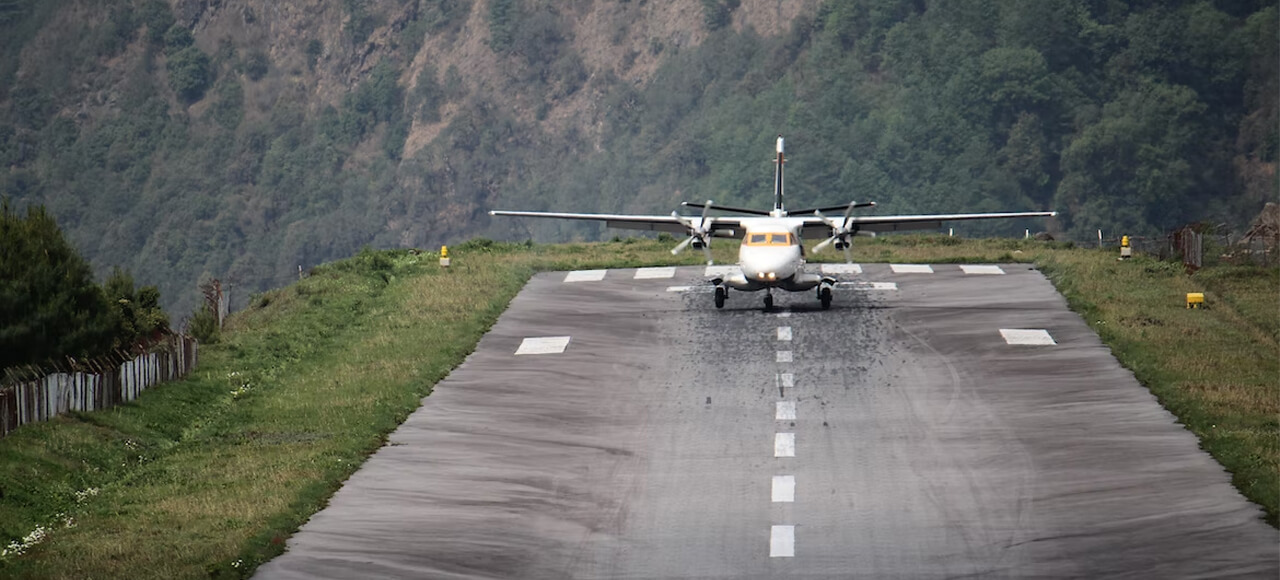
The trail will start relatively easy but will gradually become harder. You will be able to get your first glimpse of Everest as you cross the mighty Dudh Koshi. As you proceed further, the trail will lead you to Monjo, where you could make a lunch stopover. The next part of the trail will be more difficult.
The trail becomes steeper and will gain altitude as we head towards Namche, leaving one with shortness of breath. One should not haste but rather progress slowly and steadily. You will be making a pit stop at Namche Bazaar for the night. It bustles with activity, and the people of the Solukhumbu region congregate in that area to do business. Namche Bazaar offers an interesting insight into how the people in the region live.
Accommodation: an overnight stay in an available lodge in Namche Bazaar.
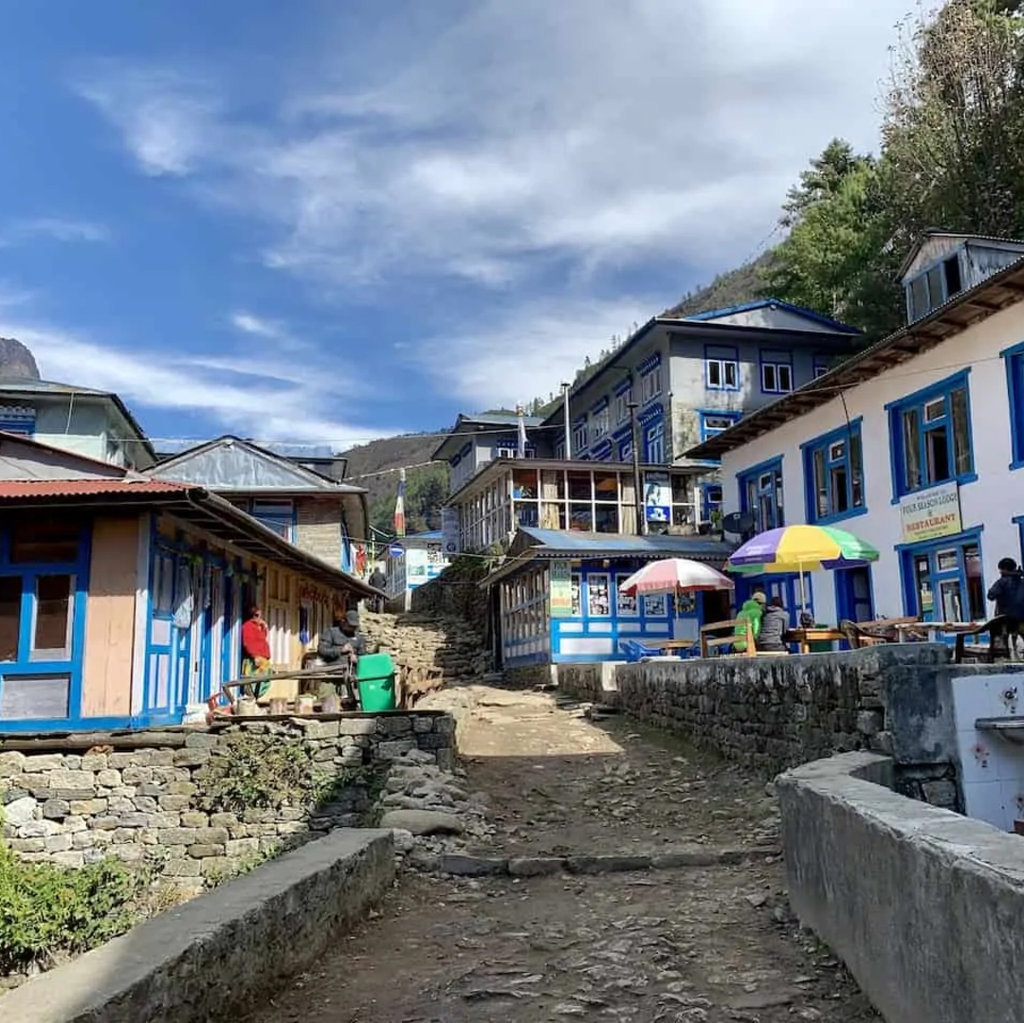
On the third day of Gokyo Lake trekking, you can use your time to acclimatize, relax, and explore around Namche Bazaar. Most of the trekkers prefer to get up before sunrise to take in the impressive views of Mount Everest, Thamserku, Ama Dablam, and other magnificent peaks from the Sagarmatha National Park Headquarters, which is perched on the east side of town and houses a museum.
You may get a chance to witness the shadow of the mountains being projected onto the clouds above and truly appreciate the magnitude of the mountains. One should try salt-butter tea and Champa, which are often consumed by the sherpas in the region. It is one of the main energy supplements there. The lively cultural Saturday market is worth a visit and is usually brimming with traders who are trying to desperately sell off their products.
Accommodation: an overnight stay in an available lodge in Namche Bazaar.

We will begin the trek to Khumjung with an early start. We will start off climbing uphill to the monastery above Thame village. If the weather is fine, you will be able to witness a scene where the natural beauty of the majestic landscape combines with the ancient Buddhist culture of the Sherpa people. After the visit, you will be heading back in the direction of Namche Bazaar towards Khumbila.
The trail eventually widens as you head towards Khumjung and follows the contour of the mountain at a slight incline. This village lies at the foot of the sacred peak, Khumbila. The Monastery there was established approximately 340 years ago, is the head of a Yeti, popularly known as the Abominable Snowman. It is a nice place to stay for the night. It is a famous place for Edmund Hillary’s lover people.
Accommodation: Overnight in available lodges in Khumjung.
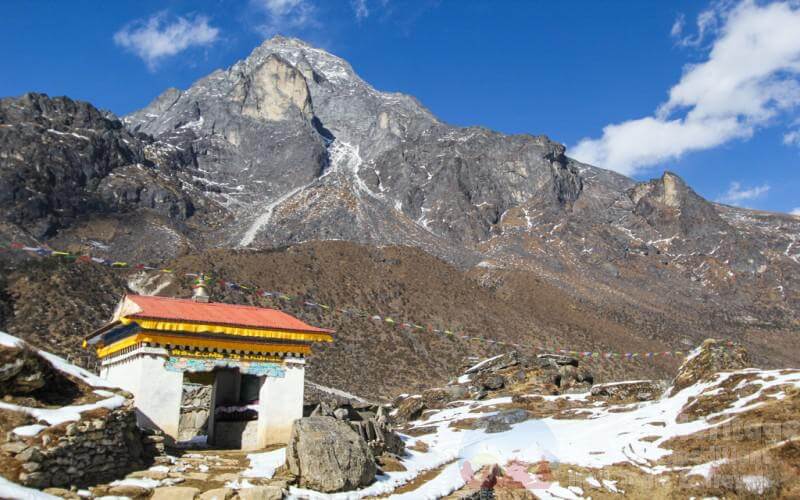
From Khumjung, we will follow the trail climbing up the side of a hill that goes around a rocky peak and drops down to a stream that flows from Gokyo Lake. We will be taking the left fork at a junction onto the path to Phortse (the town on the other side of the river) and heading north.
As you proceed on, you will be transported into a world right out of novel books; cross below frozen waterfalls, walk through moss-covered woods, and encounter unique Himalayan mammals. Emerging from the woods, the trail will pass several summer yak huts, and we will arrive at Dole.
Accommodation: an overnight stay in an available lodge in Dole.

We will be ascending out of the valley that Dole sits in, through Lhaparma and Luza, and will be getting our first glimpse of Cho Oyu. It’s one of the world’s highest peaks, at over 8000m, and serves as a constant, towering companion as we walk up the valley. The trail consists of short sections of steep climbing but is mostly a gradual traverse up to Macherma, where you will be staying for the day.
Accommodation: an overnight stay in an available lodge in Macchermo.
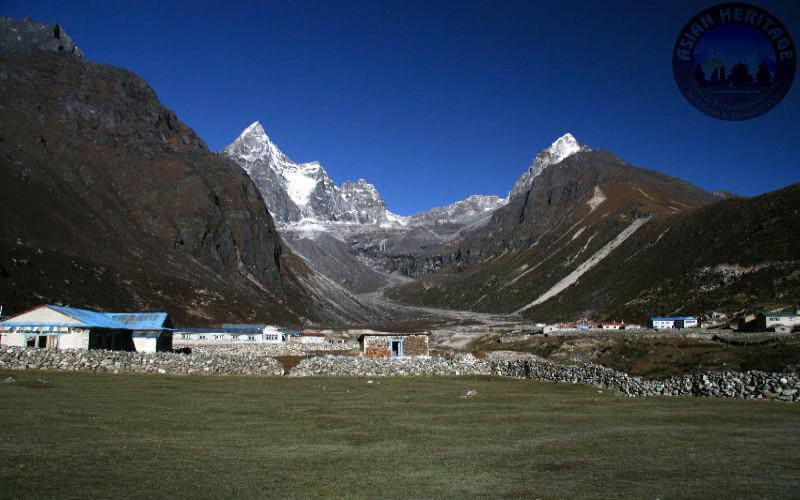
We will continue climbing uphill out of the village and then continue gradually climbing up through Pangka. There will be incredible views of Cho Oyu almost up. We will climb a short and steep section up before descending to follow a trail along the stream that crosses the river and soon emerges out to the foot of the first of three small lakes in this valley. The lake offers an incredibly beautiful view—milky blue with golden ducks swimming about.
As we continue, we will pass by the second and third lakes and finally reach Gokyo. If you are feeling adventurous, you can visit the Renjo Pass, which is known for offering views of Everest and a myriad of other surrounding peaks.
Accommodation: an overnight stay in an available lodge in Gokyo.
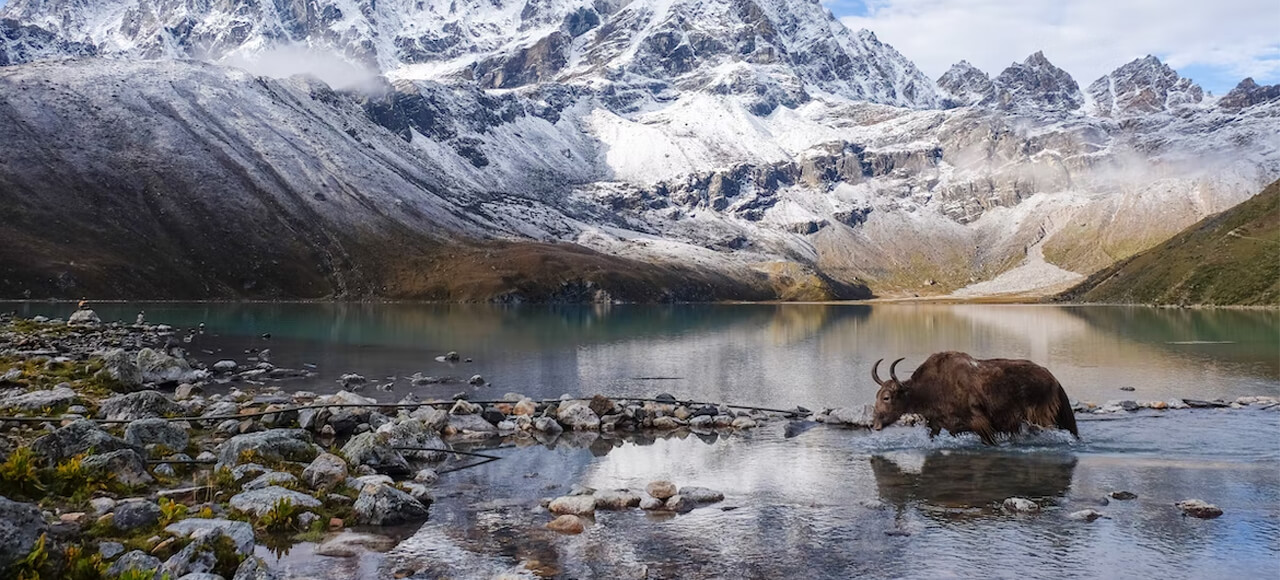
We will be climbing up to the top of Gokyo Ri, which is a small hill. Early in the morning, you will have stunning views of the Upper Gokyo Valley, the massive Ngozumpa Glacier, and an incredible panoramic view of the whole Khumbu Himalayas. Like Everest standing tall and mighty amidst Lhotse, Nuptse, Makalu (8481 m), Cho-Oyu (8153 m), Gychung Kang (7922 m), and many more. This will be one of the highlights of the trek and offers an outstanding vantage point of the Nepal Himalaya. After the mind-blowing experience, we will be returning to Gokyo.
Accommodation: an overnight stay in an available lodge in Gokyo.
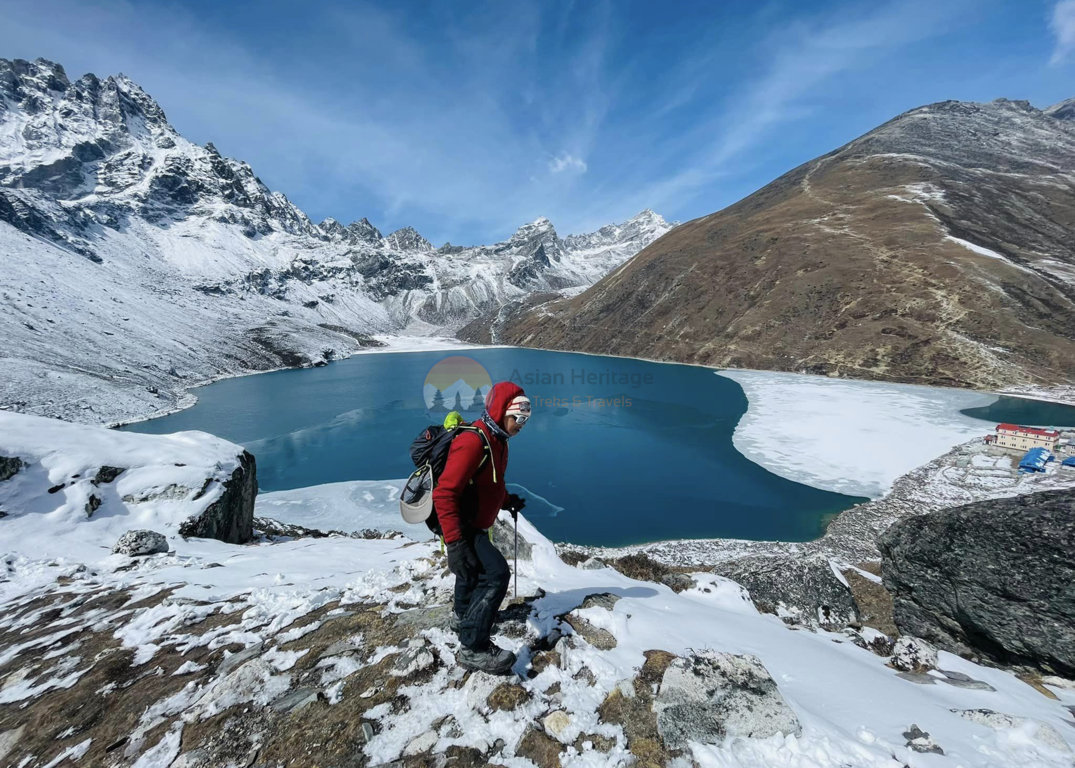
We will be descending. On our way, we will cross Dragnag and be able to see the Ngozumpa Glacier. The trail will seem easier compared to the previous part of the trek. However, one must be careful not to put too much weight and pressure on the knees. After several hours of leisurely walking, you will reach Dole.
Accommodation: an overnight stay in an available lodge in Dole.
We start walking down to Phorche Thanka, mostly through a rhododendron forest. We will stumble upon waterfalls, a prayer wheel that is run by flowing water, and a powerful, high glacier stream. Later, we will make a stopover for lunch in a small restaurant before continuing onward to Namche. Namche Bazaar is known as the Sherpa “capital.” Most of the trekkers prefer to get up before sunrise to take in the impressive views of Mount Everest, Thamserku, Ama Dablamand, and other magnificent peaks from the Sagarmatha National Park Headquarters, which is perched on the east side of town and houses a museum.
One can get a chance to witness the shadow of the mountains being projected onto the clouds above and truly appreciate the magnitude of the mountains. One should try salt-butter tea and Champa, a kind of barley often consumed by the sherpas in the region, as it is one of the main energy supplements there. The lively cultural Saturday market is worth a visit and is usually brimming with traders who are trying to desperately sell off their products.
Accommodation: an overnight stay in an available lodge in Namche.
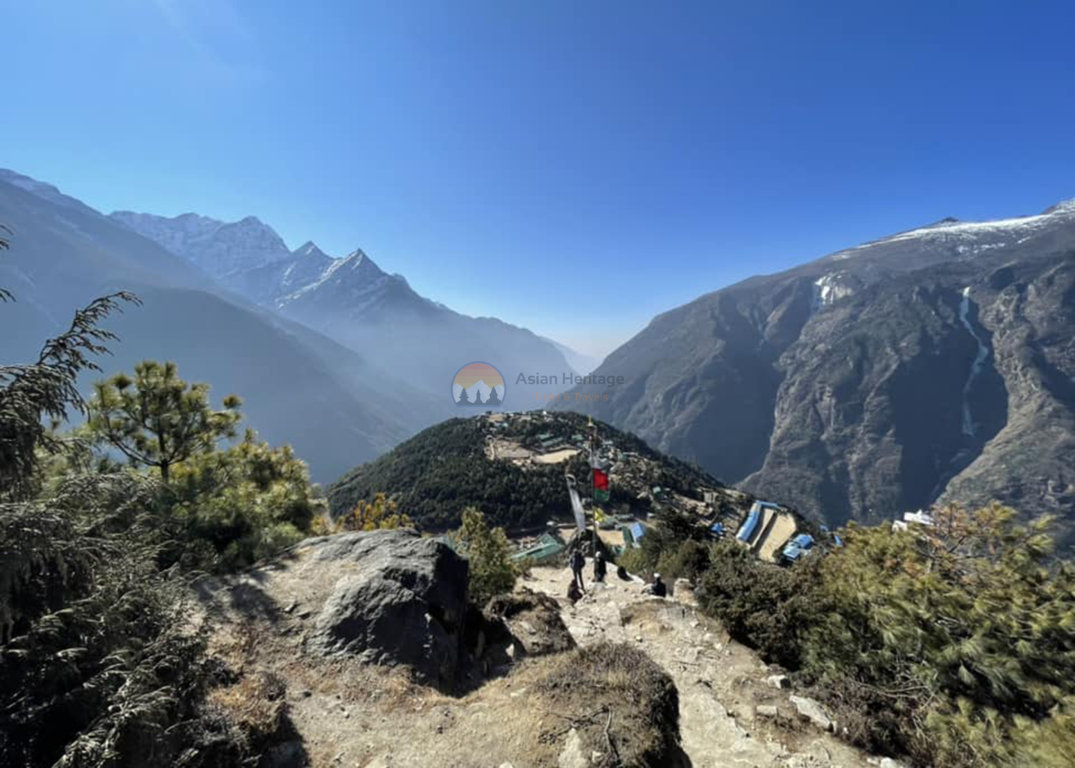
The trail follows down and crosses the Dudh Kosi, where there are a series of water-driven prayer wheels. The trek continues back to Sagarmatha National Park through the paths of pine and cedarwoods and ends in Chumoa village, a beautiful village to have lunch in. After that, the trail runs along the riverside until Phakding. At this stage, one should not feel any breathing difficulty.
Accommodation: an overnight stay in an available lodge in Phakding.

As you trek onwards to Lukla, the disappearing sight of the snowy peaks in the distance acts as an indicator that the most difficult part has a pass and the start of an end of an exciting and magnificent adventure that has pushed one to their limits. You will be entering through rhododendron forest which gives off a strong aroma of evergreen oak and trek along the Dudh Koshi (Milk River ) which can be seen meandering into the horizon. After a few hours, you will reach Lukla where you can relax and immerse yourself in the local culture.
Accommodation: Overnight in available lodge in Lukla.

The flight back to Kathmandu leaves before 10:00 a.m. It can sometimes fluctuate according to weather conditions. After arriving in Kathmandu, you’ll be transferred to your hotel. This marks the end of Gokyo Lake trekking.
Accommodation: an overnight stay in Yatri Suites & Spa or a similar hotel in Kathmandu.
It was my second visit of Khumbu region. The first visit leaves me unforgettable memories, so I visited again. I received a lot of help from Asian Heritage and Nilam in the first visit, so I contacted with him again. At this time, I accompanied with my mother. She’s mid 60s, so I worried about her. Thanks to my friend Nilam, we could successfully finish the trek. Nilam took care of every details of our trek, so my mother’s never felt uncomfortable even though it was her first abroad trip. It was monsoon season, but still amazing experience to us. We could step toward more to locals than busy season. Sometimes peaks show their head, and it was like Christmas present for us.
